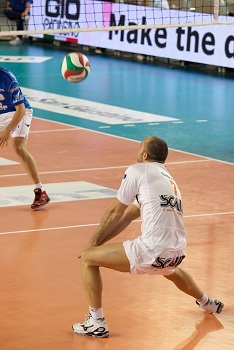Movement Techniques
Volleyball Tips for Dynamic Plays
Techniques volleyball involve various movements to make success plays.
Technique is very important
In comparison to most team sports, the skills in volleyball are fairly technical. Therefore, it's important to learn proper technique for each skill.
The main skills in volleyball are spiking, passing, setting, digging, blocking, and serving. There are specific movement patterns to learn that will allow for better skill execution.
The following are the skills and the specific movements of volleyball.
Techniques Volleyball Spiking
The key movement patterns for spiking are...
- The Approach. Spiking a volleyball consists of taking an approach to get in position to spike. The steps for right handed players are left-right-left.
Often you will need to take more than 3 steps. The key is to always have your last two steps be right foot, then left foot. Always plant and jump up off two feet.
The arms should be brought back and down as you approach. This is called a "double arm action". The arms are then quickly brought forward and up. The purpose of this symmetrical double arm action is to increase the jump height and also get the hitter in position to hit. - The Armswing. The armswing is referred to the action of the arm as the hitter is swinging to hit the ball. The arm action is much like a "bow and arrow" movement.
- The Contact. The contact refers to when the hitter contacts the ball to spike. At contact, the arm should be vertical (not a bent elbow), and the entire palm should contact the ball.
- You want all your fingers to contact the ball, not just the palm. Contact the ball with the hand in a curve-like position. Imagine clawing at the ball.
Clawing allows for more control, better placement of spikes, and a creation of topspin on the ball. Think of the ball sticking to your hand longer and creating spin on the ball. This is much different than the ball contact of serving a float serve.
Listen to the contact. The sound is much different when creating topspin vs creating a float on the ball.
If you enjoyed these tips and would like to keep it close to you at any time, just save this pin to your Pinterest Volleyball Training Board.
Digging
For forearm digging on defense, think of moving sideways leading with the heel. Get your heel to the spot first.
Next, angle your platform to the target as you absorb the spike. Focus on cushioning the ball to avoid overpassing.
There are various floor moves for playing defense. A few are... the Chinese collapse, sprawl, and pancake.
Of all the movements of volleyball, perhaps the most exciting is a defender making an unbelievable dynamic save.
Pancaking a Volleyball
Techniques Volleyball Serving
The key to serving is a consistent toss and contact.
Key movements for serving...
- Stand staggered. The body should be slightly open, not shoulders square to the court.
- Hold ball in opposite hand. Bow and arrow the arms.
- Keep the hitting elbow up. You want the elbow up as you draw the arm back.
- Make an accurate toss. A inconsistent toss is the problem with most beginning servers. Once able to get tossing consistently, the serves start to go in the court.
- Swing aiming to the target. If you have trouble getting the ball over the net, pick a spot on the ceiling above the net to aim for.
- Step, toss, and hit. Be sure to aim for something. The more you aim, the more you'll focus on something specific. The more specific the focus, usually the more accurate the serve.
Techniques Volleyball Setting
Like most skills, the key to setting is getting in position. Footwork is critical.
- Beat the ball to the spot. Be sure to get your feet there.
- Big curved hands in the shape of the ball.
- Get your hands up in plenty of time.
- Extend the arms as you set.
Techniques Volleyball Passing
Passing is a critical skill. Without a pass, a team won't have much of an offense.
- Start with hands in front of knees.
- Thumbs and wrists together.
- Elbows straight and flat.
- Get the platform out early under the ball.
- Get the feet to the ball. Be sure to beat the ball to the spot.
- Face the ball and angle the forearms to the target.
- When moving to get in position, shuffle the feet.
- Watch the opponent contact the ball to help predict where the ball is going and how the ball is going to move. For example, topspin serves drop downward into the court. Float serves are much less predictable. Some floaters rise up while others suddenly drop.
Home › Techniques › How to Move





